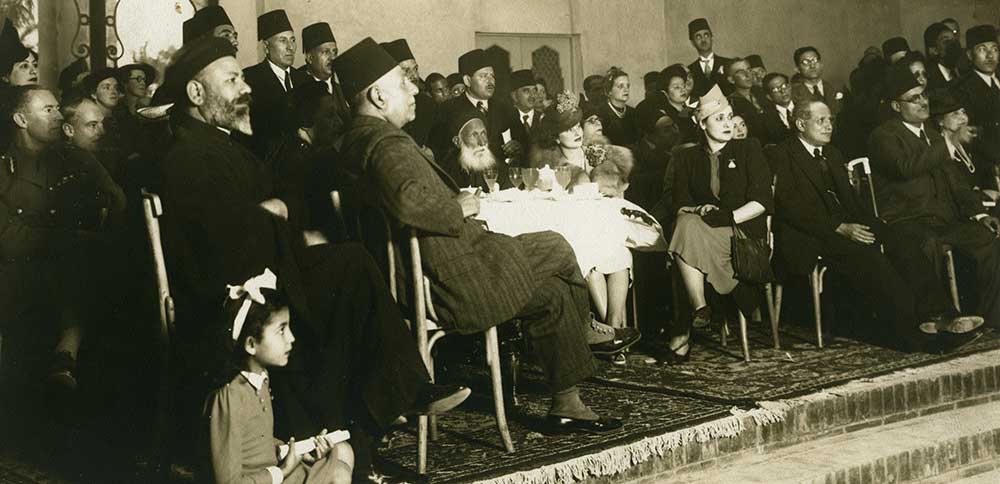Zionism: The Creation of the Jewish State in Pictures
 I recently acquired a collection of images that were used by the Zionist movement to attract Jewish settlers to Palestine. The compilations was put together shortly after the end of WWI and consists of 108 postcard-size photogravures preserved in an album with captions in Hebrew, and English. The photos were taken between 1910 and 1916 by the photographer Shlomo Narinsky, a Russian immigrant who showed beautiful, almost dreamlike landscapes of a gentrified Palestine. Even when Narinsky included shepherds and farmers in his photographs, they looked far more European than Palestine’s indigenous people.
I recently acquired a collection of images that were used by the Zionist movement to attract Jewish settlers to Palestine. The compilations was put together shortly after the end of WWI and consists of 108 postcard-size photogravures preserved in an album with captions in Hebrew, and English. The photos were taken between 1910 and 1916 by the photographer Shlomo Narinsky, a Russian immigrant who showed beautiful, almost dreamlike landscapes of a gentrified Palestine. Even when Narinsky included shepherds and farmers in his photographs, they looked far more European than Palestine’s indigenous people.
Revisiting The Imbaba Camel Market, Africa’s Largest
 The Imbaba market was the largest camel market in Africa. The camels came mostly in large overland caravans from Sudan, specifically from Kassala in the east, Omdurman just north of the capital Khartoum, and el Fasher in the west. The most famous and oldest overland route was called Darb al-Arba’in, or the 40-day route, which traditionally started in el Fasher and continued north across the open desert following wells and oases along the way until reaching Assiut in Upper Egypt. In modern times, camel caravans making the overland journey stayed closer to the Nile for a more reliable source of water and ended in Daraw, just north of Aswan. The camels were then loaded onto flatbed trucks and driven the last 900 kilometers to Imbaba. Highly prized camels from Somalia were put on ships to Suez.
The Imbaba market was the largest camel market in Africa. The camels came mostly in large overland caravans from Sudan, specifically from Kassala in the east, Omdurman just north of the capital Khartoum, and el Fasher in the west. The most famous and oldest overland route was called Darb al-Arba’in, or the 40-day route, which traditionally started in el Fasher and continued north across the open desert following wells and oases along the way until reaching Assiut in Upper Egypt. In modern times, camel caravans making the overland journey stayed closer to the Nile for a more reliable source of water and ended in Daraw, just north of Aswan. The camels were then loaded onto flatbed trucks and driven the last 900 kilometers to Imbaba. Highly prized camels from Somalia were put on ships to Suez.
Donkey and Mule Soldiers: The Unsung Heroes
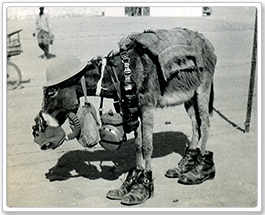 Donkeys and mules have had a distinguished career in modern warfare. As the main means for the transportation of supplies and equipment in rough terrain, these animals have been indispensable to soldiers. Surprisingly, their role as warriors only became prominent with the invention of the combustion engine at the beginning of the 20th century when other animals, including horses, were being replaced by motorized military vehicles.
Donkeys and mules have had a distinguished career in modern warfare. As the main means for the transportation of supplies and equipment in rough terrain, these animals have been indispensable to soldiers. Surprisingly, their role as warriors only became prominent with the invention of the combustion engine at the beginning of the 20th century when other animals, including horses, were being replaced by motorized military vehicles.
Farouk and Narriman: Egypt’s Last Royal Romance
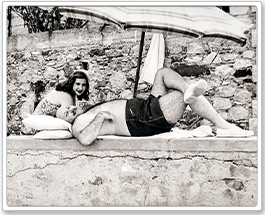 On January 26, 1952, Egyptian rioters, spurred on by political extremists from both the left and right, took to the streets of Cairo, burning everything they considered British or foreign-influenced. After that fateful “Black Saturday,” dozens of foreigners, mainly British, lay dead and hundreds of businesses and treasured landmarks were burned to the ground. Six months later King Farouk, who was vacationing with his teenage wife Narriman and their newborn son, at Alexandria’s Montazah Palace, received the dreaded news that Egypt was no longer his. Over the course of three days the royal family was ordered to abdicate, pack their personal belongings and leave. At 6pm on the evening of July 26, Farouk, his wife, son and three daughters from his previous marriage, were sent sailing into exile on the royal yacht HMS Mahroussa, by the Free Officers, led by Gamal Abd-el-Nasser. The royal family’s departure marked the end of the Mohammed Ali Dynasty’s 148-year rule. This exhibition looks at the final year on the throne and his life in exile.
On January 26, 1952, Egyptian rioters, spurred on by political extremists from both the left and right, took to the streets of Cairo, burning everything they considered British or foreign-influenced. After that fateful “Black Saturday,” dozens of foreigners, mainly British, lay dead and hundreds of businesses and treasured landmarks were burned to the ground. Six months later King Farouk, who was vacationing with his teenage wife Narriman and their newborn son, at Alexandria’s Montazah Palace, received the dreaded news that Egypt was no longer his. Over the course of three days the royal family was ordered to abdicate, pack their personal belongings and leave. At 6pm on the evening of July 26, Farouk, his wife, son and three daughters from his previous marriage, were sent sailing into exile on the royal yacht HMS Mahroussa, by the Free Officers, led by Gamal Abd-el-Nasser. The royal family’s departure marked the end of the Mohammed Ali Dynasty’s 148-year rule. This exhibition looks at the final year on the throne and his life in exile.
Baron Empain Palace: Remembering Heliopolis’ Glorious Past
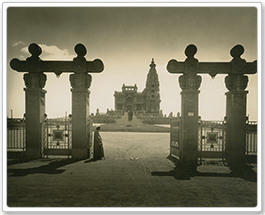 The Baron Empain Palace served as the home of Edouard Louis Joseph Empain considered the founder of Cairo’s suburb of Heliopolis. A Belgian transportation magnet who earned his nobility title after building the Paris metro, Empain expanded his empire east arriving in Egypt in the early 20th century. After developing the Cairo tramway, Empain set his eyes on the wasteland northeast of Cairo where he envisioned a brand-new extension to the city that would be the emblem of luxury and leisure. He wanted his home to be an eye-catcher at the center of this new development with stunning views over the Giza Pyramids and the desert, so he hired a talented French architect to come up with a majestic design. Even after the baron’s death in 1929 the palace continued to thrive until the 1952 revolution that overthrew the monarchy in Egypt. The abandoned structure and grounds began to deteriorate becoming dilapidated until a recent effort by the government to revive them.
The Baron Empain Palace served as the home of Edouard Louis Joseph Empain considered the founder of Cairo’s suburb of Heliopolis. A Belgian transportation magnet who earned his nobility title after building the Paris metro, Empain expanded his empire east arriving in Egypt in the early 20th century. After developing the Cairo tramway, Empain set his eyes on the wasteland northeast of Cairo where he envisioned a brand-new extension to the city that would be the emblem of luxury and leisure. He wanted his home to be an eye-catcher at the center of this new development with stunning views over the Giza Pyramids and the desert, so he hired a talented French architect to come up with a majestic design. Even after the baron’s death in 1929 the palace continued to thrive until the 1952 revolution that overthrew the monarchy in Egypt. The abandoned structure and grounds began to deteriorate becoming dilapidated until a recent effort by the government to revive them.
Chemin de Fer: The Beirut to Damascus Railroad
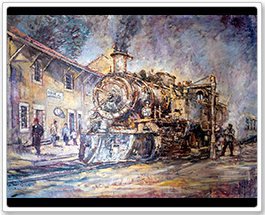 August 2020 marked the 125th anniversary of the Beirut to Damascus railway. The opening of the route for narrow gauge trains finally allowed for goods and passenger to travel between the two capitals in a record time of nine hours. The railroad, which was constructed at a time when Beirut port was under expansion, solidified the status of the Lebanese capital as home for the main shipping hub in the region.
August 2020 marked the 125th anniversary of the Beirut to Damascus railway. The opening of the route for narrow gauge trains finally allowed for goods and passenger to travel between the two capitals in a record time of nine hours. The railroad, which was constructed at a time when Beirut port was under expansion, solidified the status of the Lebanese capital as home for the main shipping hub in the region.
19th Century Tourist Snapshots: Egypt and Venice
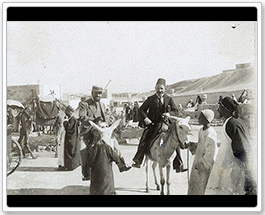 The following exhibition features images taken in February and March of 1896 by a French tourist on a journey to Egypt and Venice. When he returned from his trip, he created a photo album titled Egypte et Venise with eighty-eight 6 X 8.5cm photographs. What makes this album so unique is that it is one of the earliest examples of amateur photography by a tourist. Prior to the 1890s, the camera was too bulky and complicated to use.
The following exhibition features images taken in February and March of 1896 by a French tourist on a journey to Egypt and Venice. When he returned from his trip, he created a photo album titled Egypte et Venise with eighty-eight 6 X 8.5cm photographs. What makes this album so unique is that it is one of the earliest examples of amateur photography by a tourist. Prior to the 1890s, the camera was too bulky and complicated to use.
The Suez Canal: Celebrating 150 years (1869 – 2019)
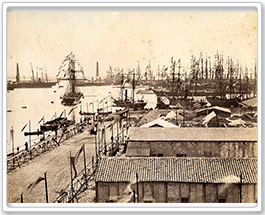 On 17 November 1869 the Suez Canal was officially opened. Dignitaries from around the world gathered at the northern entrance of the canal, in Port Said, to join the first flotilla to transit the newly constructed seaway connecting the Mediterranean to the Red Sea. Canal architect Ferdinand de Lesseps, Egyptian Khedive Ibrahim Pasha, and French Empress Eugenie were the honored guests. This exhibition features nearly 100 photographs taken in the 19th century, beginning in 1867-68. The images are from my personal collection and consist mainly of albumen prints with a few carte de visite and lantern glass positives.
On 17 November 1869 the Suez Canal was officially opened. Dignitaries from around the world gathered at the northern entrance of the canal, in Port Said, to join the first flotilla to transit the newly constructed seaway connecting the Mediterranean to the Red Sea. Canal architect Ferdinand de Lesseps, Egyptian Khedive Ibrahim Pasha, and French Empress Eugenie were the honored guests. This exhibition features nearly 100 photographs taken in the 19th century, beginning in 1867-68. The images are from my personal collection and consist mainly of albumen prints with a few carte de visite and lantern glass positives.
Yankee: Last Boat to Sail 1000 up the Nile
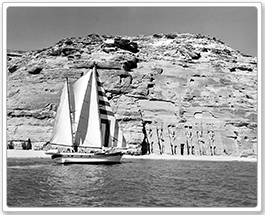 In 1963 Electa and Irving Johnson sailed their 50 foot ketch sailboat from the Greek Island of Rhodes to Egypt in hopes of sailing 1000 mile up the nile to the second Cataract before the Nile river would be permanently blocked by the High Dam. After a few weeks of battling Egyptian bureaucracy in the Port city of Alexandria the Johnsons finally got the go-ahead. This is the remarkable story of their four-month adventure with accompanying photographs.
In 1963 Electa and Irving Johnson sailed their 50 foot ketch sailboat from the Greek Island of Rhodes to Egypt in hopes of sailing 1000 mile up the nile to the second Cataract before the Nile river would be permanently blocked by the High Dam. After a few weeks of battling Egyptian bureaucracy in the Port city of Alexandria the Johnsons finally got the go-ahead. This is the remarkable story of their four-month adventure with accompanying photographs.
Operation Blue Bat: The 1958 U.S. Invasion of Lebanon
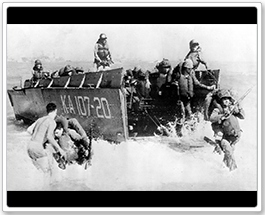 In the last decades, the United States has fought several wars in the Middle East which is still reeling from the devastating effect of these conflicts. However, the 1958 invasion of Lebanon, the U.S.’s first overt military intervention in the region, had a more positive outcome. Operation Blue Bat was the result of the Cold War-era Eisenhower Doctrine that sought to defend Middle Eastern countries from the threat of communist. In Lebanon, the Christian-led government was facing a rebellion by a coalition of mainly-Moslem opponents. While this unrest would have been considered an internal matter under any other circumstances, it became an international crisis as it coincided with a coup in Iraq that deposed its pro-Western monarch and growing popular support for Egypt’s pro-Soviet regime.
In the last decades, the United States has fought several wars in the Middle East which is still reeling from the devastating effect of these conflicts. However, the 1958 invasion of Lebanon, the U.S.’s first overt military intervention in the region, had a more positive outcome. Operation Blue Bat was the result of the Cold War-era Eisenhower Doctrine that sought to defend Middle Eastern countries from the threat of communist. In Lebanon, the Christian-led government was facing a rebellion by a coalition of mainly-Moslem opponents. While this unrest would have been considered an internal matter under any other circumstances, it became an international crisis as it coincided with a coup in Iraq that deposed its pro-Western monarch and growing popular support for Egypt’s pro-Soviet regime.
Chateau Ksara: Jesuit Winemakers of Lebanon’s Bekaa Valley
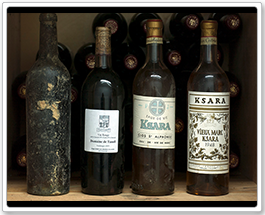 Chateau Ksara, Lebanon’s oldest winery, continues a wine making tradition that dates back to before the Phoenician era, possibly as far back as 7000 BC. In 1857, Jesuit French monks who settled in Lebanon’s Bekaa Valley, realized the potential for grapes made with French fines imported from Algeria, at the time the biggest wine hub outside France. In the beginning their production was limited to their personal consumption use but with increased demand, particularly from French troops and administrators stationed in Lebanon during the post WWI mandate period, the monks’ hobby became commercial. Michael Karam, Lebanon’s leading wine writer and author of numerous of books on the subject wrote the featured story.
Chateau Ksara, Lebanon’s oldest winery, continues a wine making tradition that dates back to before the Phoenician era, possibly as far back as 7000 BC. In 1857, Jesuit French monks who settled in Lebanon’s Bekaa Valley, realized the potential for grapes made with French fines imported from Algeria, at the time the biggest wine hub outside France. In the beginning their production was limited to their personal consumption use but with increased demand, particularly from French troops and administrators stationed in Lebanon during the post WWI mandate period, the monks’ hobby became commercial. Michael Karam, Lebanon’s leading wine writer and author of numerous of books on the subject wrote the featured story.
Lebanon in Technicolor: Growing Up in the Golden Age
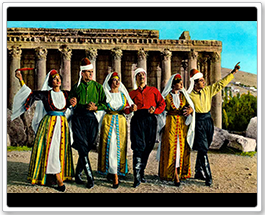 Lebanon’s Golden Age started in the mid-1950s and lasted until 1975, the beginning of the civil war. During that time, Beirut was the center of banking, commerce, and tourism in the region. The country’s physical backdrop could not have been more spectacular with its snow-capped mountains, warm sunny beaches, and charming capital with a vibrant social life and a welcoming and entrepreneurial population eager to accommodate the influx of visitors from across the globe. It was in this environment that a generation came of age. The following exhibition contains original slides from the 1950s and 1960s and rare color postcards from the same period showing life in Lebanon. Zina Hemady wrote the accompanying text which reflects on her childhood before the civil war.
Lebanon’s Golden Age started in the mid-1950s and lasted until 1975, the beginning of the civil war. During that time, Beirut was the center of banking, commerce, and tourism in the region. The country’s physical backdrop could not have been more spectacular with its snow-capped mountains, warm sunny beaches, and charming capital with a vibrant social life and a welcoming and entrepreneurial population eager to accommodate the influx of visitors from across the globe. It was in this environment that a generation came of age. The following exhibition contains original slides from the 1950s and 1960s and rare color postcards from the same period showing life in Lebanon. Zina Hemady wrote the accompanying text which reflects on her childhood before the civil war.
Van Leo: Master of Light and Shadows
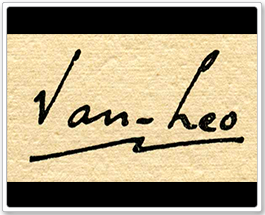 One can easily argue that Van Leo was one of the best portrait photographers that Egypt ever produced. He had a rare ability to take control of his subjects and mold them in ways no other photographer could, similar to a sculptor handling clay. For him, image composition consisted mainly of manipulating the light and shadows. Whether he was shooting a wedding or a self-portrait, what distinguished his images was how and where he focused the lighting. The following exhibition contains rare images from my personal archive and the collections of Barry Iverson, Josef Polleross, Patrick Godeau and the American University in Cairo. Both Polleross and Iverson contributed photo essays, and Iverson wrote the accompanying text.
One can easily argue that Van Leo was one of the best portrait photographers that Egypt ever produced. He had a rare ability to take control of his subjects and mold them in ways no other photographer could, similar to a sculptor handling clay. For him, image composition consisted mainly of manipulating the light and shadows. Whether he was shooting a wedding or a self-portrait, what distinguished his images was how and where he focused the lighting. The following exhibition contains rare images from my personal archive and the collections of Barry Iverson, Josef Polleross, Patrick Godeau and the American University in Cairo. Both Polleross and Iverson contributed photo essays, and Iverson wrote the accompanying text.
Egypt’s Stella Beer: Celebrating 120 Years
 On May 15 1897, Belgian investors opened Crown Brewery, Egypt’s first brewery, in the Ibrahimieh district of Alexandria. Up until then Egypt’s growing expatriate community had depended on imported beer to quench their thirst. A year later the same investors opened a second brewery on the outskirts of Cairo called Société Anonyme Brasserie des Pyramides (Pyramid Brewery). The following exhibition features historical photographs and memorabilia from my personal collection. The accompanying text is written by Omar Foda author of the upcoming book Grand Plans in Glass Bottles: A Social, Economic and Technological History of Beer in Egypt 1880-1970. Omar’s grandfather, Ismail Umar Foda, was director of ABC from 1963 to 1985.
On May 15 1897, Belgian investors opened Crown Brewery, Egypt’s first brewery, in the Ibrahimieh district of Alexandria. Up until then Egypt’s growing expatriate community had depended on imported beer to quench their thirst. A year later the same investors opened a second brewery on the outskirts of Cairo called Société Anonyme Brasserie des Pyramides (Pyramid Brewery). The following exhibition features historical photographs and memorabilia from my personal collection. The accompanying text is written by Omar Foda author of the upcoming book Grand Plans in Glass Bottles: A Social, Economic and Technological History of Beer in Egypt 1880-1970. Omar’s grandfather, Ismail Umar Foda, was director of ABC from 1963 to 1985.
Homs: A Hidden Treasure Now in Ruins
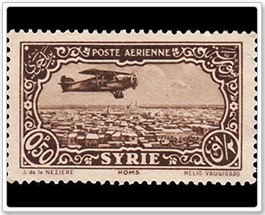 Homs is Syria’s third largest city, but because it didn’t have spectacular tourist attractions it was largely unknown to the outside world. Unfortunately, Homs was caught up very early on in the Syrian Civil War which started in 2011 and, in no time, the city became a ruin and its residents were forced to flee. This photographic exhibition features images of Homs from the 20th century. I also have included a selection of photographs that I took of the city in 2005 while working on an economic report on Syria.
Homs is Syria’s third largest city, but because it didn’t have spectacular tourist attractions it was largely unknown to the outside world. Unfortunately, Homs was caught up very early on in the Syrian Civil War which started in 2011 and, in no time, the city became a ruin and its residents were forced to flee. This photographic exhibition features images of Homs from the 20th century. I also have included a selection of photographs that I took of the city in 2005 while working on an economic report on Syria.
The Virgin’s Tree in Egypt: A Story of Survival
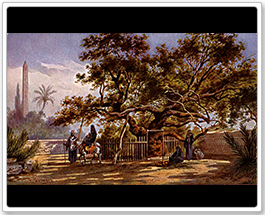 In 2013 a rumor spread that the Virgin’s Tree in Matariya, a suburb of Cairo, had been cut down by thugs seeking revenge for the Copts’ support of Abdel-Fattah el Sisi’s new government. The Coptic Church immediately denied the rumor and issued a statement saying that the tree had blown down during strong winds. The following story and photo exhibition looks at the troubled history of this sacred tree.
In 2013 a rumor spread that the Virgin’s Tree in Matariya, a suburb of Cairo, had been cut down by thugs seeking revenge for the Copts’ support of Abdel-Fattah el Sisi’s new government. The Coptic Church immediately denied the rumor and issued a statement saying that the tree had blown down during strong winds. The following story and photo exhibition looks at the troubled history of this sacred tree.
Studio el Karawan: Deir ez Zor’s Forgotten Faces
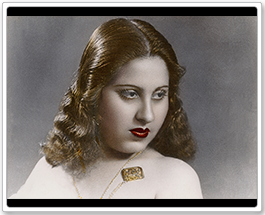 The exhibition features 22 rare hand-colored studio portraits by Armenian photographer Karawan. Patrick Godeau discovered the collection when he visited Deir Ez Zor in 2003, and acquired the photos from the late photographer’s family which, at the time, still ran the studio.
The exhibition features 22 rare hand-colored studio portraits by Armenian photographer Karawan. Patrick Godeau discovered the collection when he visited Deir Ez Zor in 2003, and acquired the photos from the late photographer’s family which, at the time, still ran the studio.
Palestine’s Nativity Trail: A Journey Through History
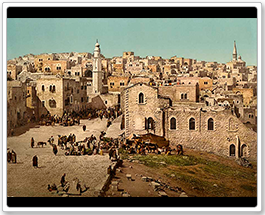 The Nativity Trail is one of the most famous of the bible’s epic journeys. In the year 2000, it became part of a larger initiative to renovate Christian sites in the Holy Land for the millennium. Shortly after it was inaugurated, the trail became inaccessible due to the Second Intifada or Palestinian uprising which exploded in 2002. Since 2008, a steady stream of pilgrims, hikers, and visitors who are curious and bold enough to discover an alternative Palestine have taken renewed interest in the journey, which takes travelers through lands and scenery that to this day evoke tales and narratives symbolic to so many across the world.
The Nativity Trail is one of the most famous of the bible’s epic journeys. In the year 2000, it became part of a larger initiative to renovate Christian sites in the Holy Land for the millennium. Shortly after it was inaugurated, the trail became inaccessible due to the Second Intifada or Palestinian uprising which exploded in 2002. Since 2008, a steady stream of pilgrims, hikers, and visitors who are curious and bold enough to discover an alternative Palestine have taken renewed interest in the journey, which takes travelers through lands and scenery that to this day evoke tales and narratives symbolic to so many across the world.
Distillerie ZOTTOS: A Greek Family Affair
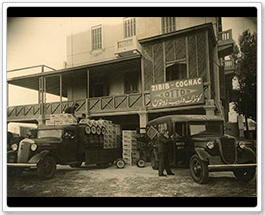 This collection of photographs taken by Studio Ververis, in Alexandria, Egypt showcases the family owned Zottos distillery in the 1930s. Greeks were instrumental in the motorization of Egypt during the 160-year rule of the Mohammed Ali Dynasty and dominated a number of industries including alcohol and non-alcoholic beverages, cotton and grocery shops .
This collection of photographs taken by Studio Ververis, in Alexandria, Egypt showcases the family owned Zottos distillery in the 1930s. Greeks were instrumental in the motorization of Egypt during the 160-year rule of the Mohammed Ali Dynasty and dominated a number of industries including alcohol and non-alcoholic beverages, cotton and grocery shops .
Palmyra: A City Rising Above the Mist
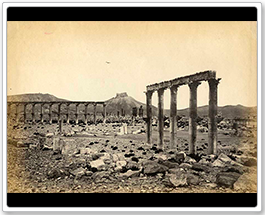 This collection of nineteenth and twentieth century photographs looks at the ancient city of Palmyra, or Tadmur, once an integral part of the Silk Road. Today, ISIS controls Palmyra, and the fate of this historic site is at stake. The group has so far destroyed the Temple of Baal, Temple of Baal Shaman, the Arch of Triumph and most recently three ancient tower tombs.
This collection of nineteenth and twentieth century photographs looks at the ancient city of Palmyra, or Tadmur, once an integral part of the Silk Road. Today, ISIS controls Palmyra, and the fate of this historic site is at stake. The group has so far destroyed the Temple of Baal, Temple of Baal Shaman, the Arch of Triumph and most recently three ancient tower tombs.
Paradise Lost: A Glimpse of Aleppo in the 20th Century
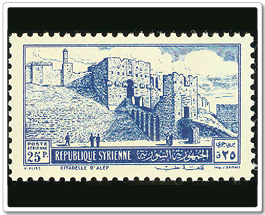 This photographic exhibition looks at Syria’s second city, Aleppo, from the late 19th century to the 1960s. Much of Aleppo’s old city and covered bazaar have since been destroyed in Syria’s protracted civil war.
This photographic exhibition looks at Syria’s second city, Aleppo, from the late 19th century to the 1960s. Much of Aleppo’s old city and covered bazaar have since been destroyed in Syria’s protracted civil war.
Weinberg and Pferschy: A Tale of Two Photographers
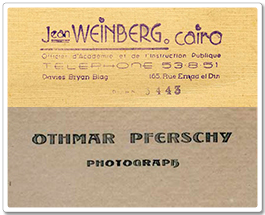 In the early 1990s I came across a small collection of five signed prints by a photographer named Othmar Pferschy. At the time, there was no information available about the photographer, so I just put the prints in a box and forgot about them. Two decades later, while moving to the United States, I rediscovered Pherschy’s photographs buried in my archives. This exhibition shows Pferschy’s works and tells his fascinating story. It also features the work of his mentor, the Romanian Jew Jean Weinberg.
In the early 1990s I came across a small collection of five signed prints by a photographer named Othmar Pferschy. At the time, there was no information available about the photographer, so I just put the prints in a box and forgot about them. Two decades later, while moving to the United States, I rediscovered Pherschy’s photographs buried in my archives. This exhibition shows Pferschy’s works and tells his fascinating story. It also features the work of his mentor, the Romanian Jew Jean Weinberg.
